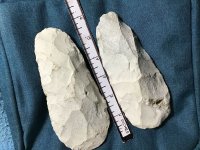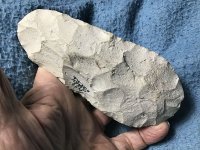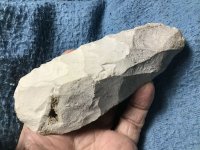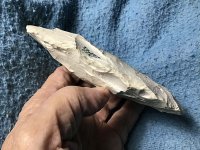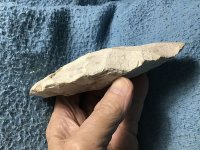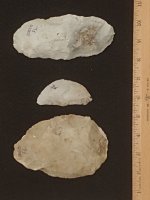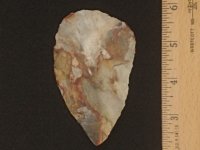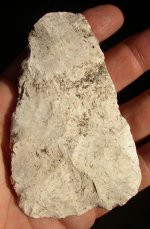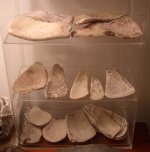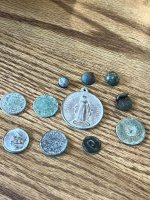You are using an out of date browser. It may not display this or other websites correctly.
You should upgrade or use an alternative browser.
You should upgrade or use an alternative browser.
Celts
- Thread starter H.P.
- Start date
flinthunter
Hero Member
- Jan 3, 2011
- 899
- 1,074
- Detector(s) used
- E-Trac, V3i, DFX
- Primary Interest:
- All Treasure Hunting
I'm thinking more of an adz than celts.
sandchip
Silver Member
- Oct 29, 2010
- 4,351
- 6,871
- Detector(s) used
- Teknetics T2SE
- Primary Interest:
- All Treasure Hunting
I'm thinking more of an adz than celts.
Hard to say without side views. Very nice pair, regardless.
Tdog
Silver Member
My vote is not an adze.
- Nov 3, 2018
- 2,720
- 5,787
- Detector(s) used
- O.G. XP DEUS
- Primary Interest:
- All Treasure Hunting
I’m leaning more toward hoe...
ArfieBoy
Silver Member
- Aug 11, 2011
- 3,407
- 5,663
- Detector(s) used
- Compass X-70, Compass X-80, Compass X-90, Compass Judge 2, Garrett AT Pro
- Primary Interest:
- All Treasure Hunting
Nice finds1 I'm not knowledgeable enough about native artifacts to have any idea, but I sure enjoy seeing the ones being found and posted on here! Thanks everyone.
antmike915
Silver Member
nice flaked celts H.P.
newnan man
Gold Member
H.P.
Hero Member
- Thread starter
- #11
I don’t care about hijackers, hitchhikers, etc. I love it ..that’s the way to see what’s been found, I have a pair I found together I’ll do in my next post.View attachment 1867159 View attachment 1867160
Not trying to hijack your thread but just wanted to show a few Pasco County celts/blades.
Without use wear on the edge showing its hard to make a definite determination on what tool they are in my view.
At six inches and exhibiting broad percussion flaking with what looks like little to none pressure flaking, these may be large blades in the middle of manufacture stage. Possibly cached for a later period and then never retrieved by the maker.
If a hoe or spade tool and had been used, a lot of edge polish would be evident as well as grass cuttings into the material over time, giving a ridged tool like appearance. I don't see that.
If a adz, likewise the bit portion would have exhibited more polish from use, but no cut area from grassland digging. I don't see that either.
Here is a close up of an edge wear of a notched hoe showing serrations where the grass cuttings wore into the flint. You can see what appears to be lines in the polish which are the areas cut into the flint from use.

So they could be flint adzs, or hoes, or blades in mid manufacture. That's the beauty of the native american style of living. A multi faceted tool kit.
At six inches and exhibiting broad percussion flaking with what looks like little to none pressure flaking, these may be large blades in the middle of manufacture stage. Possibly cached for a later period and then never retrieved by the maker.
If a hoe or spade tool and had been used, a lot of edge polish would be evident as well as grass cuttings into the material over time, giving a ridged tool like appearance. I don't see that.
If a adz, likewise the bit portion would have exhibited more polish from use, but no cut area from grassland digging. I don't see that either.
Here is a close up of an edge wear of a notched hoe showing serrations where the grass cuttings wore into the flint. You can see what appears to be lines in the polish which are the areas cut into the flint from use.

So they could be flint adzs, or hoes, or blades in mid manufacture. That's the beauty of the native american style of living. A multi faceted tool kit.
Michelle S
Greenie
Nice find!
H.P.
Hero Member
- Thread starter
- #14
While most of what you say is true, I can say the ole boy could never, at this stage of knapping thin these pieces..The angles are too steep as evidenced in the side view, therefore, I submit to you that they are finished pieces, never used of unknown use, without splitting hairs any further, Thank yo for the comment, always up for learning.Nice find!
H.P.
Hero Member
- Thread starter
- #15
I don’t know how to properly navigate this sit yet, and my response might be below, too much trouble to retype it, sorry.Without use wear on the edge showing its hard to make a definite determination on what tool they are in my view.
At six inches and exhibiting broad percussion flaking with what looks like little to none pressure flaking, these may be large blades in the middle of manufacture stage. Possibly cached for a later period and then never retrieved by the maker.
If a hoe or spade tool and had been used, a lot of edge polish would be evident as well as grass cuttings into the material over time, giving a ridged tool like appearance. I don't see that.
If a adz, likewise the bit portion would have exhibited more polish from use, but no cut area from grassland digging. I don't see that either.
Here is a close up of an edge wear of a notched hoe showing serrations where the grass cuttings wore into the flint. You can see what appears to be lines in the polish which are the areas cut into the flint from use.
View attachment 1867826
So they could be flint adzs, or hoes, or blades in mid manufacture. That's the beauty of the native american style of living. A multi faceted tool kit.
tomclark
Bronze Member
- Dec 18, 2006
- 1,177
- 1,641
- Detector(s) used
- ShadowX2, TEJON, Eyes, Pony Shovel
- Primary Interest:
- Other
uniface
Silver Member
Nice !!!
Top Member Reactions
-
 2411
2411 -
 1123
1123 -
 1121
1121 -
 908
908 -
 826
826 -
 807
807 -
 765
765 -
 730
730 -
 644
644 -
 521
521 -
 479
479 -
 466
466 -
 460
460 -
 428
428 -
 407
407 -
 406
406 -
O
369
-
 364
364 -
 358
358 -
 351
351
Users who are viewing this thread
Total: 2 (members: 0, guests: 2)
